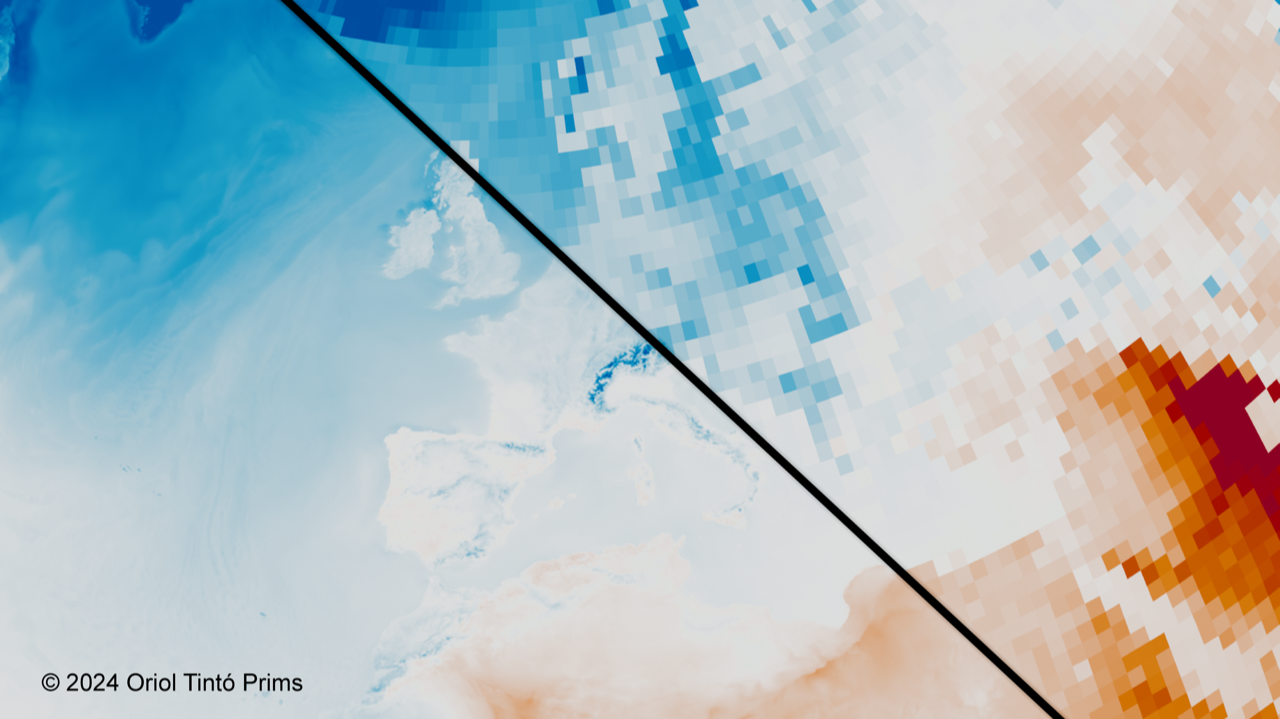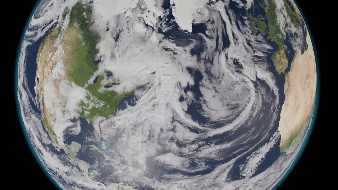- WP1 - Project Management.
- WP2 - Project dissemination, exploitation and communication.
- WP3 - Data Management.
- WP4 - Frontier simulations and standard evaluation.
- WP5 - Evaluation of ocean mesoscale processes and their interactions with the atmosphere and sea-ice.
- WP6 - Impact of the ocean mesoscale on the state and change of the ocean.
- WP7 - Impact of the ocean mesoscale on climate variability and teleconnections.
- WP8 - Role of ocean mesoscale on regional expression of climate change.
- WP9 - Efficient protocols for usable eddy-rich Earth System Modelling.
- WP10 - Model developments for realistic and efficient ER-ESMs.
- WP11 - Development of efficient and portable workflows and diagnostics for ER-ESMs.
- WP12 - Enhancing models and model analysis with Machine Learning.
Led by AWI, Work Package 1 provides oversight and strategic guidance throughout EERIE’s 48-month duration. WP1 integrates project administration and scientific collaboration while ensuring EU compliance.
The EERIE Project Office (EPO) is the first point of contact for partners & EU alike. It coordinates daily activities and addresses challenges proactively. Within the EERIE Coordination Team (together with Coordinator & Co-Coordinators), EPO drives strategic direction, ensuring project momentum and good governance.
Fostering scientific collaboration within both the EERIE consortium and the global scientific community is key: The EERIE Scientific Steering Committee (SSC) and the EERIE External Expert Advisory Board (EEAB) are pivotal in steering EERIE's research focus and promoting external scientific engagement. This approach highlights EERIE's commitment to advancing climate research through well-coordinated management.
WP2, led by Predictia, is in charge of both internal and external communications, as well as dissemination and exploitation of the data produced by the project.
In particular, this work package takes care of:
- Designing and developing the website, one of the key elements of the communications effort, as well as managing, coordinating content publication and updating it.
- Social media management on several platforms, content creation for promoting the project’s activities and news.
- Developing engaging storylines to show stakeholders and end users potential use of the data produced.
- Creating a data viewer to facilitate interpretation and use of the data obtained.
- Making data obtained available via repositories and long-term archives.
WP3 coordinates the data generated, collected, processed and stored by the project, ensuring that it is available to users, archived safely at the end of the project and complies with the FAIR (Findability, Accessibility, Interoperability, and Reusability) principles.
Led by Met Office, this WP provides tools to allow the data produced by all modelling centres (the reference simulations are estimated to produce over 5 PB of model output data) to be searchable and discoverable from the central analysis facility at JASMIN.
It also monitors, controls and assists the flow of data through the project from production to publication on the Earth System Grid Federation and cloud, while supporting users working with the data.
WP4, led by Met Office, will deliver a set of Earth-System Models (ESM) simulations that will form the backbone of EERIE analysis.
It is expected to:
- Produce reference coupled climate simulations with four ESMs at high-resolution (eddy-rich ~10 km grid spacing in ocean), and optionally lower resolution (~25–50 km grid spacing), using the CMIP6 protocol 1850–2100+ with two future scenarios, and the HighResMIP protocol 1950–2100 with the same scenarios.
- Produce tipping point experiments in line with the NAHosMIP experimental design.
- Use standard evaluation tools such as ESMValTool to benchmark simulation performance, comparing across models/resolutions and against the CMIP6 ensemble.
- Benchmark model capabilities (e.g. ocean spin-up cost, model speed, production of diagnostics), as reference for developments planned in WP9-12.
WP5’s goal is to make an assessment of the representation of ocean and atmospheric mesoscale processes from Phase 1 simulations in comparison to observations.
Additionally, mesoscale air-sea interactions and mesoscale sea-ice-ocean-atmosphere interactions will be assessed, ensuring connection and collaboration with broader communities.
More specifically, this WP, led by ETH Zürich, will determine the coupling strength at the mesoscale in the present, past, and future, both with regard to dynamical and thermodynamic coupling, and the consequence for the oceanic and atmospheric dynamics/state, as well as identify the role of mesoscale processes for the interactions between sea-ice, ocean and atmosphere.

Led by MPI-MET, WP6 is working to advance the knowledge of the impact of ocean mesoscale eddies and fine-scale boundary currents on the oceanic state under present-day and future climate conditions, in a fully coupled global framework. In addition, this work package will evaluate ocean model biases in EERIE simulations.
WP6 is expected to quantify:
- The effects of resolved mesoscales on the mean state and variability of basin-scale circulations, with focus on heat and freshwater budgets, basin-scale sea level, ocean heat and carbon uptake.
- The effect of the spatio-temporal heterogeneity caused by eddies on the ocean mixed layer, upper ocean stratification, ventilation and deep water formation, as well as any changes in these processes in the future.
- The effects of the mesoscale on the ocean’s response to global warming using hosing experiments.
The overarching goal of WP7, led by ECMWF, is to improve our understanding of the local and remote impacts of the ocean mesoscale on the large-scale atmospheric circulation, including influences on the climatological mean state and variability across weather and climate timescales.
This work will combine evidence from observations, reanalyses, and a hierarchy of model simulations, including the EERIE eddy-rich coupled simulations, idealized experiments with prescribed sea-surface temperatures, and existing CMIP/HighResMIP simulations. Important scientific questions that we hope to address in this work package include:
- What is the relative importance of time-varying eddies vs Sea-Surface Temperature fronts for the global atmosphere mean state and variability?
- Does increased atmospheric resolution amplify the response to the ocean mesoscale in model simulations?
- Can eddies drive climate/weather variability beyond the local marine atmospheric boundary layer?
WP8, led by BSC, builds on the scientific knowledge acquired in WP5, 6 and 7 on the key role of mesoscale interactions in both local and large-scale climate variability, to develop a comprehensive understanding of how these interactions will ultimately affect the way climate change unfolds at the regional scale.
In particular, WP8 will inform us on the climatic impacts associated with potential climate surprises (like an abrupt collapse of the ocean circulation), with a strong focus on future changes in climatic extremes (from convective storms to marine heat waves) and climate-driven societal impacts (like the outbreak of infectious diseases), and will develop several storylines focused on Africa, South America and Europe to showcase the main findings.

Led by University of Reading, WP9 will perform idealised atmosphere-only experiments that target understanding the role of the ocean mesoscale on weather and climate, including the role of atmospheric resolution, to complement EERIE frontier coupled integrations.
Combining all EERIE outputs, and working with the community (e.g. CMIP, WCRP, NextGEMS), WP9 will assess the relative strengths and weaknesses of different protocols for production of robust, usable climate information in the most efficient ways and make future recommendations.
In order to achieve the latter, it will develop and test new experimental designs that optimise insights from both multi-centennial and shorter coupled simulations to deliver user-relevant climate information in time-and-energy efficient ways.
Work Package 10 addresses the challenge of advancing Eddy-Rich Earth-System Models optimized for ~10 km resolution.
Led by the Alfred Wegener Institute (AWI), this work package focuses on developing efficient, scalable models that achieve high throughput while minimizing energy consumption.
The work package also explores accelerated methods for ocean spin-up, significantly reducing the "elapsed time to usable information" from these models.
Additionally, it creates purpose-built physics and integrated diagnostics to address carbon and heat uptake, enhancing the scientific performance of models at ~10 km scales and below, including improvements in parameterization and coupling.
Finally, it provides resources to address model limitations at eddy-rich resolutions identified by the scientific work packages.
WP11 will develop tools and scalable, transferable, reproducible workflows to enable efficient production of model diagnostics from Eddy-Rich Earth-System Models (ER-ESMs) while minimising permanent storage costs. It will also investigate data compression methods.
More precisely, this WP, led by BSC-CNS, will:
- Enable the objective assessment of the model realism and effective scientific analysis of ER-ESMs at 10 km by combined use of high-resolution observations and models.
- Develop novel online diagnostic tools in support of model evaluation and scientific analysis.
- Develop stand-alone solutions and data-processing workflows that can be shared and implemented by the different modelling systems to enable quick data dissemination and usage on various platforms.
- Establish scalable workflows for robust and efficient model simulations at high-resolution.
Led by the University of Oxford, WP12 is both using existing Machine Learning (ML) tools and developing novel ML-based approaches to address the computational challenges of Eddy-Rich Earth-System Models (ER-ESMs), including ocean spin-up, model evaluation and understanding, with WPs9-11.
It’s also leveraging ML to maximally extract knowledge from the EERIE simulations with WPs5-8, and informing policy decisions through developing improved linkages with Intregrated Assessment Models.
Finally, it will work to bridge the gap between ER-ESMs and convection permitting resolutions by developing ML-based parameterisations. A focus will be on developing tools that can be adopted by the wider community (i.e. model independent), providing a strong pathway to impact.
